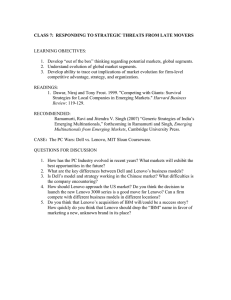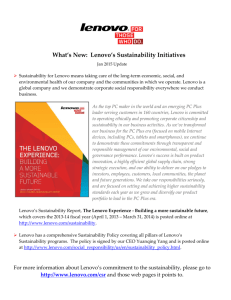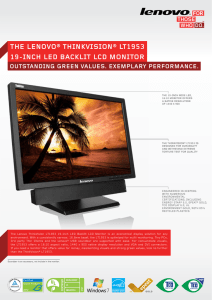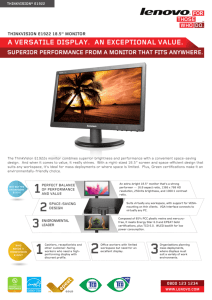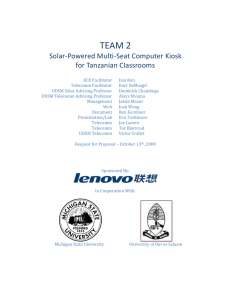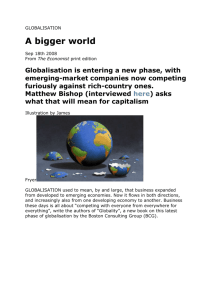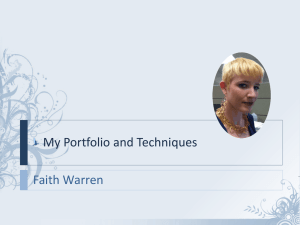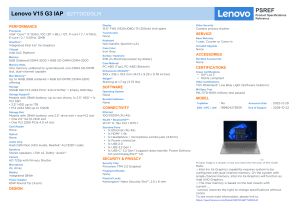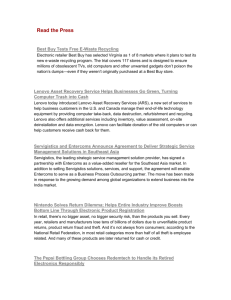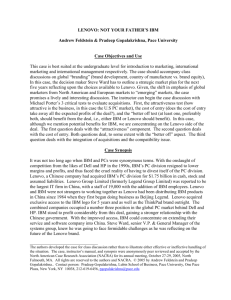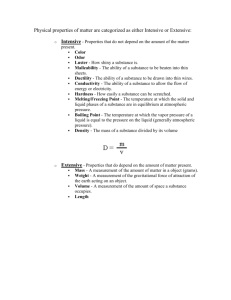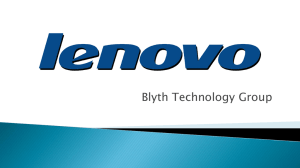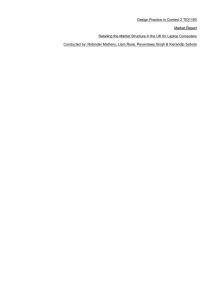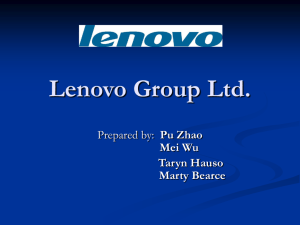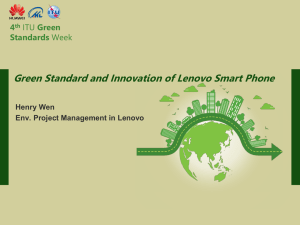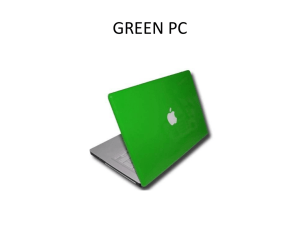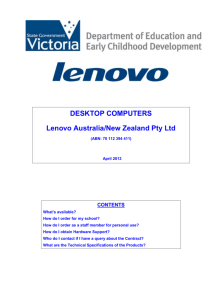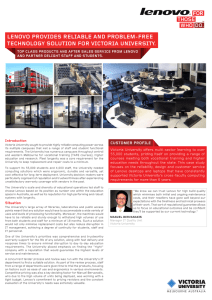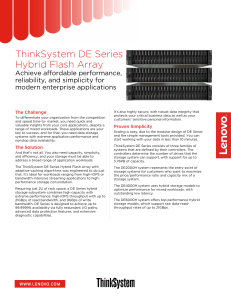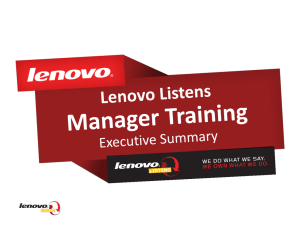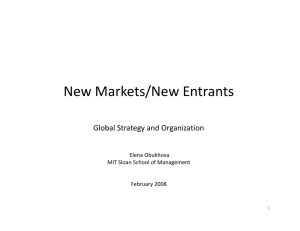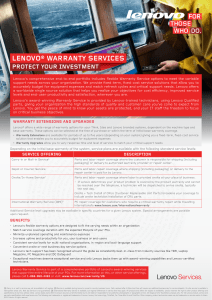doc
advertisement
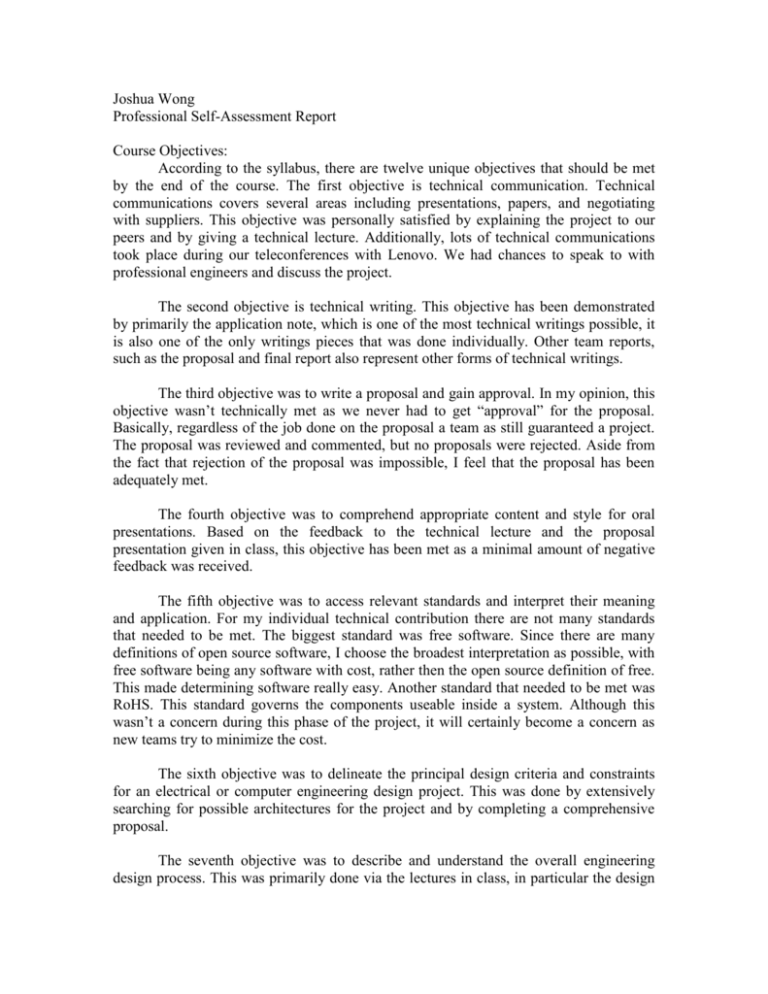
Joshua Wong Professional Self-Assessment Report Course Objectives: According to the syllabus, there are twelve unique objectives that should be met by the end of the course. The first objective is technical communication. Technical communications covers several areas including presentations, papers, and negotiating with suppliers. This objective was personally satisfied by explaining the project to our peers and by giving a technical lecture. Additionally, lots of technical communications took place during our teleconferences with Lenovo. We had chances to speak to with professional engineers and discuss the project. The second objective is technical writing. This objective has been demonstrated by primarily the application note, which is one of the most technical writings possible, it is also one of the only writings pieces that was done individually. Other team reports, such as the proposal and final report also represent other forms of technical writings. The third objective was to write a proposal and gain approval. In my opinion, this objective wasn’t technically met as we never had to get “approval” for the proposal. Basically, regardless of the job done on the proposal a team as still guaranteed a project. The proposal was reviewed and commented, but no proposals were rejected. Aside from the fact that rejection of the proposal was impossible, I feel that the proposal has been adequately met. The fourth objective was to comprehend appropriate content and style for oral presentations. Based on the feedback to the technical lecture and the proposal presentation given in class, this objective has been met as a minimal amount of negative feedback was received. The fifth objective was to access relevant standards and interpret their meaning and application. For my individual technical contribution there are not many standards that needed to be met. The biggest standard was free software. Since there are many definitions of open source software, I choose the broadest interpretation as possible, with free software being any software with cost, rather then the open source definition of free. This made determining software really easy. Another standard that needed to be met was RoHS. This standard governs the components useable inside a system. Although this wasn’t a concern during this phase of the project, it will certainly become a concern as new teams try to minimize the cost. The sixth objective was to delineate the principal design criteria and constraints for an electrical or computer engineering design project. This was done by extensively searching for possible architectures for the project and by completing a comprehensive proposal. The seventh objective was to describe and understand the overall engineering design process. This was primarily done via the lectures in class, in particular the design for six sigma lectures and the Gantt chart lectures. A lot of this was applied early in there year when our team decided on the basic architecture of the system. The eighth objective was to describe and understand contemporary industry practices and trends with respect to electrical and computer engineering. One of the major things I had to do for this project was to contact the developers of certain software to get bugs fixed and to better understand how the software works. The ninth objective was to describe, understand, and apply key tools used in the overall electrical and computer engineering design process. Many of the key tools such as decision matrixes, were taught to us during the design for six sigma part. Unfortunately most of these design tools were taught too late for them to be much use in design process. It is strongly recommended that the design for six sigma be moved to the start of the class, where we still have the time to make design decisions. The tenth objective was to understand the benefits and potential problems of teaming, describe qualities and processes of effective teams, and describe the role of teamwork in system design. One of the major problems of teaming was the fact that each member of the team had a different idea on what the best way to solve the problem we were given. In a way, this difference of opinion forced us to pick the best product, as we were all trying to prove our idea better then our peers. The eleventh objective was to acquire and understand information contained in contemporary technical literature about hardware components, software, design tools, third-party suppliers. This objective is obsolete, as all the information available in traditional literature in the computer science industry is available online. The twelfth and final objective was to browse the web to acquire information about electrical and computer engineering, software, design tools, third-party suppliers, etc. This objective was demonstrated by my discovering of the multiseat approach. This approach has not been documented in traditional literature. The primary developers of the final solution were made by people in Brasil, with almost no US connection. Only by an exhaustive search of the web was I able to discover the multiseat approach and ways to fix the bugs associated with the approach. I would qualify that all objectives set forth in the syllabus were met. Some were met better then others, but all of the objectives have been demonstrated in some way. The only objective that was not met was the contemporary literature search. This is not really important as, companies like Google are scanning contemporary literature and making it available online. Design Process For this project, my primary technical responsibility was to find and implement a multi-terminal solution. Initially I started with thin clients. However, after talking with Lenovo, we realized that thin clients are not part of their plan and I shifted my focus to the multiseat approach which is currently implemented. The first topic I researched was using LTSP for a thin client based solution. This solution was very promising and very powerful. It allows a large number of computers to share resources with minimal additional overhead. LTSP also allowed for trivial booting of compatible thin clients. Typically thin clients require a lot of configuration, but using LTSP and PXE booting, I was able to bypass most of the configuration. However, after talks with Lenovo, the thin client idea was rejected for business reasons. We were given an additional design requirement of using Lenovo hardware. Based on this new requirement, we decided to try the multiseat approach. Based on the available literature, we found the minimum specs of a multiseat system. These specs were higher then the specs required for thin clients, but still very reasonable. A computer meeting those specifications was ordered from Lenovo. Unfortunately, Lenovo didn’t have the exact computer we wanted avaliable, but they had a more expensive, comparable model. In the future, I am sure that a cheaper model can be deployed. The hard part of the multiseat solution was the software. Initially we thought we would have to develop the software from scratch, as most of the solutions documented on the internet were very old and incompatible with the latest Linux distributions. By doing a very deep search, I was able to uncover the hidden gem, mdm. MDM is a program being developed at C3SL, in Brasil. This program allows a single computer meeting the proper specification to be used as many separate computers. The program was still in its infancy and lots of work was needed to bring it to a useable state. Using a multiseat computable computer and the mdm software is our final design and thus far there are no known unsolvable problems. Technical Communications: Personally I was responsible for creating an application note and this self assessment. As a team member, I provided assistance in all the other reports and presentations. For the proposal and pre-proposal I contributed to writing about the multiseat and thin client approaches. For the proposal presentation, I spoke to the class about the advantages of the multiseat approach over all the other possible approaches. For the status reports, I wrote on the progress being made on the multiseat approach. On the technical lecture regarding current measuring, my job was to provide a general overview of current sensing techniques. For the application note, I provided instructions on creating a generic multiseat system. It is unknown at this point what my contribution to the final report will be. Another major form of technical communications was our teleconferences with Lenovo. Although some of the members of the Lenovo team were not engineers, there were several engineers available for each conference. By attending these meetings I was able to gain valuable experience about how meeting are conducted and how to discuss technical problems with non-technical people. Impact of the course: Overall I felt that this course had tremendous impact on my career objectives and professional goals. Sometime during my senior year I decided that grad school was not right for me immediately after graduation. I strongly believe that because of the things I learned, such as design for six sigma, and the depth of my involvement in the project convinced several of the companies that I have interviewed with that I was a good candidate. Additionally, this course taught me a lot about team design and participating in large scale team projects. Primary Strength and Weakness: I believe my primary strength is my desire to excel. Just finishing something isn’t good enough for me. I want to be the best at whatever I do with no exceptions. Many people are satisfied with simply graduating from college. I was not satisfied unless I graduated with a high GPA. Another example is this multiseat system. A long time ago in the beginning of the semester, I discovered an acceptable solution that was far from the ideal solution. Being unsatisfied with that, I kept working until I discovered a far better solution that is now being implemented. My greatest weakness is my also my desire to excel. Sometime I get too involved into solving a problem that I lose sight of the big picture. Luckily for this project, I had teammates who would tell me that some problems have been solved enough and it is time to move onto other problems. Professional target: Within five years of graduation I have to have a Master’s degree and be making progress towards a PhD. Right now I have received an offer of employment from Infosys and I plan to spend several years in industry then attempt to have my employer provide funding for higher education. An additional goal I have is to be able to one day start my own company. I have lots of good ideas, just the lack of time and resources to start. Life long learning. In order to successfully get a Master’s degree by the end of five years, I have to make sure I keep up with the latest developments in the industry. Working with Infosys will help, as they work closely with many key industries. I may also consider getting an MBA instead of getting a traditional engineering degree, as I feel that an MBA would help me achieve me ultimate goal of starting my own company.
